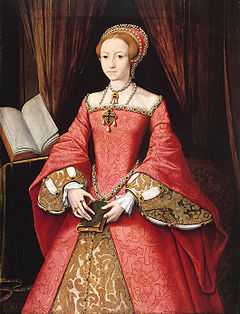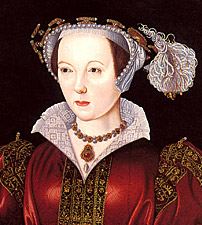An English Queen and Child Abuse? February 16, 2013
Author: Beach Combing | in : Modern , trackbackThere are three characters in this sorry tale: a 14 year old girl, her forty-one year old step-father and her thirty-six year old step-mother; the girl’s biological father and mother are both dead. The child attracts her step-father’s attention (sexually-speaking) and he begins to take liberties with the girl: though how far these liberties went has never been established, opinons range from ‘horseplay’ to pregnancy. Then, on occasion his wife helps him. A sordid little play from the back pages of the nasty newspapers? Not a bit of it. These shenanigans involved a future queen of England, an English lord and a widowed queen in 1547/1548: respectively the teenage Elizabeth I (pictured above), villainous Thomas Seymour (pictured below) and Katherine Parr, Henry VIII’s last wife.
In the modern day, of course, this episode would be, given Elizabeth’s age, a case for the courts. Some have tried to relativise the scandal away, noting that modern ideas of statutory rape had no place in the Tudor world. Elizabeth was, they argue, after all, doubtless a ‘woman’ by fourteen and could have even been married under the laws and practices of her day. But the authorities ‘of her day’ were horrified when these incidents came to light. Then, she was under the protection of her step parents. That is surely the point that cuts across the centuries and different sexual mores. The people who should have looked after her did quite the opposite: tell that to an Amazonian hunter gatherer or a New York taxi driver and the reaction you will get is the same.
So was the virgin queen deflowered long before she even came to the throne by an unpleasant bully? We know more than we might otherwise because these events became part of a legal inquiry when Thomas Seymour tried to take over England in a remarkably incompetent coup d’état which ended with a single dog dying. From these legal records we learn that Thomas had begun with physical palming and an unsuitable familiarity:
And if she were up [from bed], he would bid hir good morrow, and ax how she did, and strike hir upon the Bak or on the Buttocks famylearly, and so go forth through his lodgings; and sometimes go through to the Maydens, and play with them, and so go forth: And if she were in hyr Bed, he wold put open the Curteyns, and bid hir good morrow, and make as though he wold come at hir: And she wold go further in the Bed, so that he could not come at hir.
Elizabeth seems, according to one source, to have enjoyed the attention: Thomas was a handsome and brilliant man and she was a child. She may later have considered marrying him: Katherine Parr died after childbirth in 1547 and he pressed his suit. But, in an early display of that judgment that served Elizabeth and her country so well, she took to getting up before TS and making sure that she was fully dressed when he came into the chamber. Perhaps the great mystery is why Katherine Parr joined in the romps. On one occasions she and her husband ‘tickled lady Elizabeth on the bed’ and on another she held Elizabeth down while TS cut Elizabeth’s black mourning dress to bits: Beach finds this second episode particularly sinister. The strange thing is that Katharine Parr (pictured below) was a decent person, actually rather more. She had been married to Henry VIII (and survived!). She was deeply religious. It is also striking that all Henry’s children came to love her. Elizabeth seems to have never lost her adoration for KP. The real mystery is not that TS could not control his passion but that KP joined in: drbeachcombing At yahoo DOT com
How to explain this peculiar lapse of judgment on Katharine’s part, TS can be explained away with the male menopause, a moral vacuum and hormones? The first thing to understand is that KP had loved Seymour for many years. She had turned down his earlier suit so as to marry Henry VIII, but Thomas was apparently the man she wanted. (God knows what would have happened had she stupidly said ‘yes’ to Thomas and ‘no’ to the king). Very possibly she saw what was happening with her step-daughter – in fact, she had been warned by Elizabeth’s shrewd governess – and joined in to direct the ‘play’ away from anything too sexual. She was pregnant in 1548, the pregnancy that would kill her, and she may have felt unable to compete with a teenage girl in terms of ‘flashing beauty’. And it was Katharine who finally sent Elizabeth away. Elizabeth left chastened but her affection for Katharine clearly survived the telling off and, indeed, the years.





